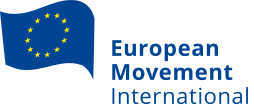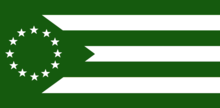European Movement International
 | |
| Formation | July 1947 |
|---|---|
| Type | Lobbying association |
| Headquarters | 21 rue Marie-Thérèse, Brussels[1] |
| Location | |
President | Jo Leinen, MEP[2] |
Key people | Eva Paunova, Frédéric Vallier, Bernd Hüttemann, Natasa Owens, Ugo Ferruta, Jean Marie Cavada |
| Website | www.europeanmovement.eu |
The European Movement International is a lobbying association that coordinates the efforts of associations and national councils with the goal of promoting European integration, and disseminating information about it.[3]
History
The origins of the European Movement date to July 1947, when the cause of a united Europe was being promoted by notables such as Duncan Sandys in the form of the Anglo-French United European Movement. The UEM acted as a platform for the co-ordination of the organisations created in the wake of World War II. As a result of their efforts, the congress of The Committee for the Co-ordination of the European Movements took place in Paris on 17 July 1947 incorporating "La Ligue Européenne de Coopération Economique" (LECE), "l'Union Européenne des Fédéralistes" (UEF), "l'Union Parlementaire Européenne" (UPE) and the Anglo-French United European Movements. They met again on 10 November 1947 and changed their name to The Joint International Committee for European Unity. They retained this name until after the 1948 Congress of The Hague.

From 7 to 11 May 1948, 800 delegates from Europe and observers from Canada and the United States gathered in The Hague, the Netherlands for the Congress of Europe. Organised by the International Committee of the Movements for European Unity and presided over by Winston Churchill, the Congress brought together representatives from across a broad political spectrum, providing them with the opportunity to discuss ideas about the development of European Union. Important political figures such as Konrad Adenauer, Winston Churchill, Harold Macmillan, Bertrand Russell, François Mitterrand, Paul-Henri Spaak, Albert Coppé and Altiero Spinelli took an active role in the congress and a call was launched for a political, economic and monetary Union of Europe. This landmark conference was to have a profound influence on the shape of the European Movement, which was created soon afterwards.

The European Movement was formally created on 25 October 1948, when the Joint International Committee for European Unity decided to change its name. Duncan Sandys was elected President and Léon Blum, Winston Churchill, Alcide De Gasperi and Paul-Henri Spaak were elected as Honorary Presidents. The U.S. policy was to promote a United States of Europe, and to this end the American Committee on United Europe committee was used to discreetly funnel CIA funds to such organisations as this.[4]
The first major achievement of the European Movement was the setting up of the Council of Europe in May 1949. The European Movement was also responsible for the creation of the College of Europe in Bruges and the European Center of Culture in Geneva. One of its major functions during the 1950s through to the 1990s was the setting up of think-tanks and a network of discussion groups across Europe, in countries both democratic and Communist.
Since 1948, the European Movement has lobbied for further integration, on numerous subjects. It worked in favour of the direct election of the European Parliament by all European citizens, in favour of the Treaty on the European Union (the Maastricht Treaty) and also for a European Constitution.
Presidents
| Name | Term |
|---|---|
| Jo Leinen | November 2011 to date |
| Pat Cox | 2005-2011 |
| José María Gil-Robles | 1999-2005 |
| Mário Soares | 1997-1999 |
| Valéry Giscard d'Estaing | 1989-1997 |
| Enrique Barón Crespo | 1987-1989 |
| Giuseppe Petrilli | 1981-1987 |
| Georges Berthoin | 1978-1981 |
| Jean Rey | 1974-1978 |
| Walter Hallstein | 1968-1974 |
| Maurice Faure | 1961-1968 |
| Robert Schuman | 1955-1961 |
| Paul-Henri Spaak | 1950-1955 |
| Duncan Sandys | 1948-1950 |
Secretaries General
| Name | Term |
|---|---|
| Diogo Pinto | 2009-2015 |
| Henrik Kröner | 2002-2009 |
| Pier Virgilio Dastoli | 1995-2001 |
| Giampiero Orsello | 1993-1995 |
| Bob Molenaar | 1987-1993 |
| Luigi Vittorio Majocchi | 1985-1987 |
| Sjouke Jonker | 1984 |
| Thomas Jansen | 1981-1983 |
| Robert Van Schendel | 1955-1980 |
| Georges Rebattet (London office) | 1948-1955 |
| Józef Retinger (Paris office, from 11/1951 Brussel office) | 1948-1950 |
Philosophy
The Movement's stated objective is to "contribute to the establishment of a united, federal Europe founded on the principles of peace, democracy, liberty, solidarity, and respect for basic human rights. It seeks to provide a structure to encourage and facilitate the active participation of citizens and civil society organisations in the development of a united Europe". Its various Councils and Associations, under the co-ordination of the European Movement International (EMI), work to influence major decision-makers across European civil society - its multitudinous associations, governments, politicians, political parties, enterprises, trade unions and individual lobbyists - to achieve these ends. The Movement focuses its attentions on seeking further integration in the political, social and cultural arenas, using its network of lobbyists to achieve those ends.
The EM also works as a study and information group operating through various projects and activities. It tries to involve larger segments of the public in the European project by disseminating information on European affairs and activities and getting them involved in its projects.
The association attempts to remain pluralist, and integrates into its management political personalities from both the Right and the Left.
Organisation
The Movement's central office, located in Brussels, is headed up by a President and six Vice-Presidents, all of whom usually hold significant offices in the European Union or other pan-European organisations. Honorary Presidents, generally prominent European politicians (for example Valéry Giscard d'Estaing), are also elected, but hold no executive powers.
The current President of the EMI is Jo Leinen, MEP. The management of the organisation is drawn from across Europe.
International Associations
The EMI currently has 35 International Member Associations:[5]
- The European Association for National Trade Organisations representing the European Manufacturers of Weighing Instruments – CECIP
- Council of European Dentists - CED
- Council of the Notariats of the European Union - CNUE
- The European Association for the Education of Adults (EAEA)
- European Association of Retirement Schemes for Liberal Professions - EurelPro
- European Confederation of Veterans
- European Centre for Culture - ECC
- European League of Economic Cooperation - ELEC
- Europeans Throughout the World - ETTW
- Permanent Forum of the European Civil Society
- European Association of Teachers - AEDE
- Erasmus Student Network - ESN
- Association des Etats Généraux des Etudiants de l'Europe - AEGEE
- Association of Women of Southern Europe - AFEM
- Association of Local Democracy Agencies - ALDA
- European Confederation of Independent Trade Unions - CESI
- Council of European Municipalities and Regions - CEMR
- European Citizens' Action Service - ECAS
- European Trade Union Confederation - ETUC
- European People's Party - EPP
- Alliance of Liberals and Democrats for Europe Party - ALDE
- European Organisation of Military Associations - EUROMIL
- International Association of Former Officials of the European Communities - AIACE
- International Centre for European Studies - CIFE
- The European Grouping of Societies of Authors and Composers - GESAC
- Young European Federalists - JEF
- Party of European Socialists - PES
- Rurality Environment Development - R.E.D.
- SOLIDAR
- Union Syndicale Fédérale - USF
- Union of European Federalists - UEF
- Democracy International
- European Friends of Armenia – EuFoA
- Eyes & Ears Europe
- Parti Démocrate Européen | European Democratic Party - PDE
Supporting Members
- College of Europe
- Foundation Euractiv
- The Kosovar Civil Society Foundation - KCSF
National Councils
At national level there are National Councils in 39 countries, organized in a very diverse way.[6] In principle national councils of all countries which are members of the Council of Europe can join the European Movement. Only on national level the EM has youth branches.[7]
Board
Policy is formulated by a Board, the chairmanship of which is held by the President. A 'Federal Assembly', made up of delegates from local Movements throughout Europe, foments policies for the EMI and is in charge of the organisation's Auditors. Several specialist committees, devoted to the discussion of individual policies exist as well. The current Political Committees are: More Democracy, Citizens’ Rights and Freedom; Jobs, Competitiveness and Sustainable Growth; and Europe in the World. Day-to-day office-work is performed by the staff, which is led by a Secretary General, since June 2009 Diogo Pinto.
Current Members of the Board are: President: Jo Leinen; Vice-presidents international organisations: Frédéric Vallier, Ugo Ferruta, Eva Paunova; Vice-presidents national councils: Bernd Hüttemann, Natasa Owens, Jean-Marie Cavada; Treasurer: Dries Callens; Board members: Daniel Correa, Federica Sabbati, Christof-Sebastian Klitz, Olivier Hinnekens, Christian Wenning, Jean Marie Beaupuy, Maja Bobić, Noel Clehane, Aleksandra Kluczka, Roselyne Lefrançois, Claudia Muttin, Katja Tuokko.[8]
See also
- European Movement Belgium
- European Movement in Finland
- European Movement Germany
- European Movement Ireland
- European Movement UK
References
- ↑ "European Movement International, Author at Citizens For Europe : Citizens For Europe". Citizensforeurope.eu. Retrieved 2016-02-05.
- ↑ "Jo Leinen". Europarl.europa.eu. Retrieved 2016-02-05.
- ↑ International Youth Secretariat (1953). "European+Movement.+International+Youth+Secretariat"&dq=inauthor:"European+Movement.+International+Youth+Secretariat" European Movement. NA: Charles Scribner's Sons. p. 22.
- ↑ telegraph.co.uk: "Euro-federalists financed by US spy chiefs" 19 Sep 2000
- ↑ Friday 5th Feb 2016. "Greens join pro-European parties' network". Euobserver.com. Retrieved 2016-02-05.
- ↑ some councils are just consisting of individual members while historically the "councils" consisted mainly of associations (e.g. Italy, Germany, Spain)
- ↑ Such as the Young European Movement UK, which are usually the national sections of the Young European Federalists (JEF). On European level JEF is youth organisation of the Union of European Federalists.
- ↑ See Homepage EMI
External links
| Wikimedia Commons has media related to European Movement International. |
- Official website
- Historical fonds of European Movement at the Historical Archives of the EU in Florence